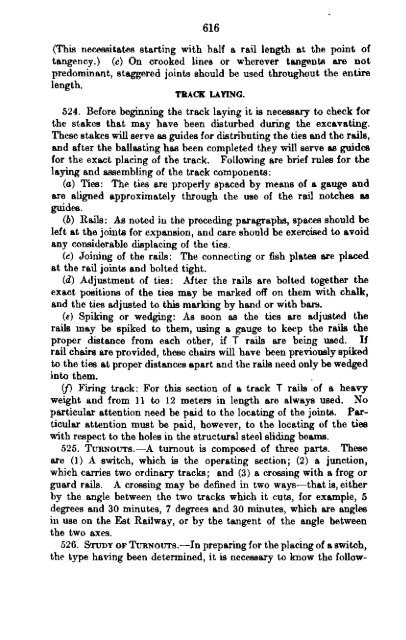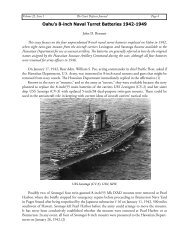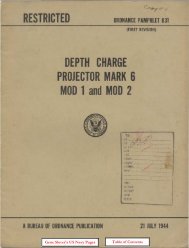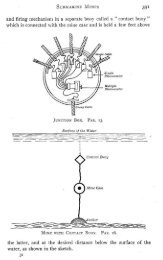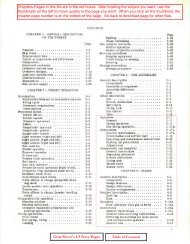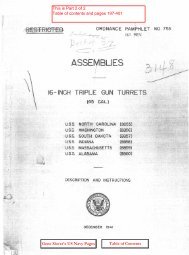...Railway artillery - Personal Page of GENE SLOVER
...Railway artillery - Personal Page of GENE SLOVER
...Railway artillery - Personal Page of GENE SLOVER
Create successful ePaper yourself
Turn your PDF publications into a flip-book with our unique Google optimized e-Paper software.
616<br />
(This necessitates starting with half a rail length at the point <strong>of</strong><br />
tangency.) (c) On crooked lines or wherever tangents are not<br />
predominant, staggered joints should be used throughout the entire<br />
length.<br />
TRACK LAYING.<br />
524. Before beginning the track laying it is necessary to check for<br />
the stakes that may have been disturbed during the excavating.<br />
These stakes.will serve as guides for distributing the ties and the rails,<br />
and after the ballasting has been completed they will serve as guides<br />
for the exact placing <strong>of</strong> the track. Following are brief rules for the<br />
laying and assembling <strong>of</strong> the track components:<br />
(a) Ties: The ties are properly spaced by means <strong>of</strong> a gauge and<br />
are aligned approximately through the use <strong>of</strong> the rail notches as<br />
guides.<br />
(b) Rails: As noted in the preceding paragraphs, spaces should be<br />
left at the joints for expansion, and care should be exercised to avoid<br />
any considerable displacing <strong>of</strong> the ties.<br />
(c) Joining <strong>of</strong> the rails: The connecting or fish plates are placed<br />
at the rail joints and bolted tight.<br />
(d) Adjustment <strong>of</strong> ties: After the rails are bolted together the<br />
exact positions <strong>of</strong> the ties may be marked <strong>of</strong>f on them with chalk,<br />
and the ties adjusted to this marking by hand or with bars.<br />
(e) Spiking or wedging: As soon 88 the ties are adjusted the<br />
rails may be spiked to them, using a gauge to keep the rails the<br />
proper distance from each other, if T rails are being used. If<br />
rail chairs are provided, these chairs will have been previously spiked<br />
to the ties at proper distances apart and the rails need only be wedged<br />
into them. .<br />
if) Firing track: For this' section <strong>of</strong> a track T rails <strong>of</strong> a heavy<br />
weight and from 11 to 12 meters in length are always used. No<br />
particular attention need be paid to the locating <strong>of</strong> the joints. Particular<br />
attention must be paid, however, to the locating <strong>of</strong> the ties<br />
with respect to the holes in the structural steel sliding beams.<br />
525. TuRNOUTS.-A turnout is composed <strong>of</strong> three parts. These<br />
are (1) A switch, which is the operating section; (2) a junction,<br />
which carries two ordinary tracks; and (3) a crossing with a frog or<br />
guard rails. A crossing may be defined in two ways-that is, either<br />
by the angle between the two tracks which it cuts, for example, 5<br />
degrees and 30 minutes, 7 degrees and 30 minutes, which are angles<br />
in use on the Est <strong>Railway</strong>, or by the tangent <strong>of</strong> the angle between<br />
the two axes.<br />
526. STUDY OF TuRNoUTs.-In preparing for the placing <strong>of</strong> a switch,<br />
the type having been determined, it is necessary to know the follow-<br />
Digitized by Coogle


